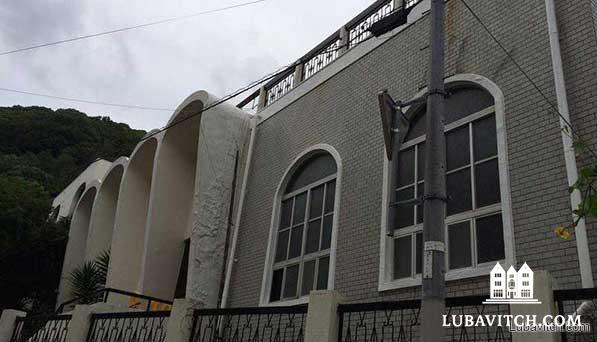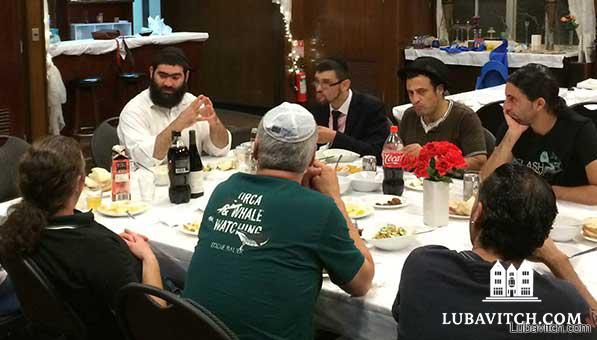The Kansai (Kinki), historic Jewish community was in shambles when American bombers took out its synagogue and Jewish community center in Kobe, Japan in 1944. It was only four years earlier when the Japanese opened their borders, respecting Chiune Sugihara, their diplomat and Vice Consul to Lithuania. After the bombing, the Jews of the city mourned and fasted, with the war waging, and no one to turn to for assistance.
It took the commitment of local businessman Rahmo Sassoon, whose generosity is still felt today by new Chabad representatives Rabbi Shmuel and Batya Vishedsky, to help sustain a semblance of Jewish life here. The Vishedskys arrived last Spring, putting down roots in this unikely place. Their objective, of course, is to build a strong community for the 2,500 Jews in the Kansai region, an area that includes Osaka, Kobe and Kyoto.
Given the difficulties entailed in obtaining kosher food, locating living quarters large enough for a growing family (most live in spaces barely over 400 sq feet), and the high cost of living here, the Vishedskys feel that some element of the miraculous plays a role in their lives there. “Miraculous” seems to be a term that comes up a lot in any discussion about Kansai’s Jewish community, one that survived a revolving door of people coming and going with only a small core group of permanent residents.
“Pure will power, it is really for the history books,” says Rabbi Marvin Tokayer, historian of Japanese Jewish history, about the synagogue’s survival and always having some Jewish activity, if it was even minimal. “How they keep the synagogue going is really miraculous.”
Many credit the community’s survival to Sassoon. Born in the ancient Jewish community of Aleppo, Syria, he lived in Japan since 1936. During the war years he served as liaison of the Jews of Kobe with the Japanese government.
With no synagogue after the war, Sassoon offered to host the community in a warehouse he owned. He named the synagogue the Ohel Shlomo, in memory of his father. In 1964, Sassoon moved to New York, where he continued to be an advocate for the Jewish community. Shortly thereafter, he donated the warehouse to the Jewish community in Kansai.

According to local lore, before the Americans bombed the community center there were two sanctuaries in the synagogue, one for the Sephardic community and one for the Ashkenazic community. When Mr. Sassoon donated his warehouse for the synagogue, all the Jews prayed together. “This is the way it is today; all the Jews here, all from different backgrounds pray together in harmony,” says Rabbi Vishedsky.
During a private audience with the Lubavitcher Rebbe, Rabbi Menachem Mendel Schneerson, of righteous memory, Sassoon spoke to him about the Kobe synagogue. The Rebbe asked him “Where is the mikvah?” the ritual bath. The philanthropist said that there was no place for one on the premises of the synagogue. The Rebbe asked him draw the basic layout of the synagogue. Once done, the Rebbe took his pencil and drew a location where the mikvah could be built. That is where it was built back in the 1970’s. Today, the mikvah is in poor condition, but is still in use.
The synagogue continued to survive in the ensuing decades, but as the local Japanese Jews slowly died, the community began to wane. Tony Yair Levy, a jewelry and cosmetics store owner, who has been living in the country for the past eighteen years and is the president of the Ohel Shlomo synagogue, asked Rabbi Mendy Sudakevitch, Chabad representative to Tokyo, Japan, to send a Chabad representatives to the city.
When Sudakevitch discussed the post with the Vishedskys, they balked at the idea.
“Japan is a very expensive country to live in. It would be a very difficult challenge for us to be able to function and raise a family there,” said Vishedsky. “A tomato costs a $1.50. To make salads for Shabbat, with many guests, could cost $2000. And the apartments here are very small and are not made for large families, like ours.”
But Levy persisted in his request, and Sudakevitch finally convinced the Vishedskys to go there for the holiday of Purim. The young couple planned a community Purim event, and eighty people showed up. The refrain he kept hearing at the party was, “‘we need a rabbi here,” Rabbi Vishedsky recalls.
Still undecided if they wanted to move here, a conversation with an elderly Jew who lived in the country since 1960 settled the matter. “Understand that unless we have a rabbi here, we do not know if we will receive a Jewish burial,” Yaakov Yehudah Yochai pleaded. The elderly man was suffering from a terminal illness and was understandably worried.
The Vishedskys arrived in time for Passover. More than 150 Jews, among them Israelis, Americans and Europeans, participated at a communal Seder. The numbers grew, and over the High Holidays more Jews arrived.
Shortly after the High Holidays, Yochai, a long-standing pillar of the community, died. The Chabad rabbi was there to honor him with a proper Jewish burial.
Plans on the drawing board, say the Chabad representatives, include making kosher food available, opening a preschool and repairing the existing mikvah. In the meantime, the area’s Jews are enjoying new opportunities to participate in community events, educational classes and prayer services.
“Our new rabbi is reaching out to all Jews with open arms, respect and love,” says Michael Fox, Associate Professor at Hyōgo University who lives in Kobe.
During the week, Vishedsky travels from location to location, reaching out to the local Jews. The feedback he gets, “the warm welcome and open hearts of the Jewish community here,” he says, keep him and his wife going, challenges notwithstanding.
“There’s something miraculous about it all,” he adds.

Raphael Wiener
Israel needs urgent help! ! !
I’m an Israeli living in Japan for about 40 years.
Israel needs urgent help.
A little help from you can go a long way.
Japanese media is not reporting the facts.
It is our duty to tell the Japanese people the truth and spread the truth.
I translated a request for help to free Israeli children from kidnapping by Hamas. Please help spread the word.
Please cooperate by publishing in the media and, if possible, printing posters and pasting them on the streets of Japan.
It is important to spread only the truth in a way that is acceptable to the Japanese people.
I started a Facebook group for this purpose
The poster can be found below.
https://www.facebook.com/groups/1338945800329289
Please email us for further arrangements.
wiener.rafi@gmail.com